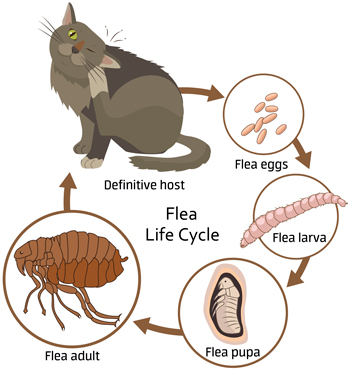Medical Articles in Maple Grove
Biology of the Cat and Dog Flea (Ctenocephalides felis)
Fleas are magical creatures that have been annoying animals for over 60 million years. With their flattened bodies and three pairs of powerful legs, they are magnificently adapted for jumping. The average flea is capable of jumping more than 100 times its own height. It is extremely easy for a flea to jump from one pet to another.
Ctenocephalides felis, the cat flea, is the most common flea found on dogs and cats. Other fleas may parasitize dogs and cats; however, the cat flea is the predominant skin parasite in the United States.
Life Cycle
There are four stages to the life cycle of the flea: adult, egg, larva, and pupa. The adult flea spends most of its time on the host (dog or cat). Development of the egg, larva, and pupa takes place in the environment (off the pet). In order for flea control to be effective, the environment as well as the pet must be treated.
Adult fleas are blood suckers. In order to reach sexual maturity, reproduce and lay eggs, immature adult fleas require blood from their host. When on the host, these skin parasites feed daily or every other day. Male fleas only require a minimum amount of blood, however females require much more. The life span of the adult flea ranges from six to 12 months. Length of survival depends upon temperature and humidity. The adult and larval stages do not survive well in extreme temperature conditions. The ideal temperature is 65-80 degrees F with 75 to 85 percent humidity.
While on the host, the adult female flea lays eggs. She is capable of laying 30-60 eggs per day. Some of the eggs remain on the dog or cat; however, most fall into the environment. The eggs are often located in carpets, sofas, chairs with fabric upholstery, animal beds, and kennels. Flea eggs are found in areas where pets spends most of their time.

Like chicken eggs, flea eggs must incubate. Incubation time is variable, depending upon the temperature and humidity. Under favorable conditions, this period is two to six days. After incubation, the larva emerges from the egg. The flea larva resembles a microscopic-size worm and undergoes a series of changes. In a few weeks, the larva spins a small cocoon and transforms into a pupa. The pupal stage is extremely resistant and can survive for up to two years in unfavorable conditions. This must be taken into consideration when treating an area for fleas!
The adult flea emerges from the cocoon, jumps on a cat or dog, and the cycle begins again. Under ideal conditions, the entire cycle may take only 18 days to complete.
In the warmer, more humid areas of the United States, the flea cycle is short. With adult fleas emerging every three weeks, pets are infested year-round. In the northern parts of the country, there is a reprieve during the winter months. During the cold weather, pupae remain dormant. By late spring, when the temperature and humidity increase significantly, large numbers of pupae emerge and the flea problem begins again.
Ctenocephalides felis serves as the intermediate host for the dog and cat tapeworm. Pets often ingest fleas during grooming. The tapeworm is released inside the digestive tract of the pet where it attaches to the lining of the intestine.
[ Search Articles ] [ Article Index ] [ Previous Page ]
